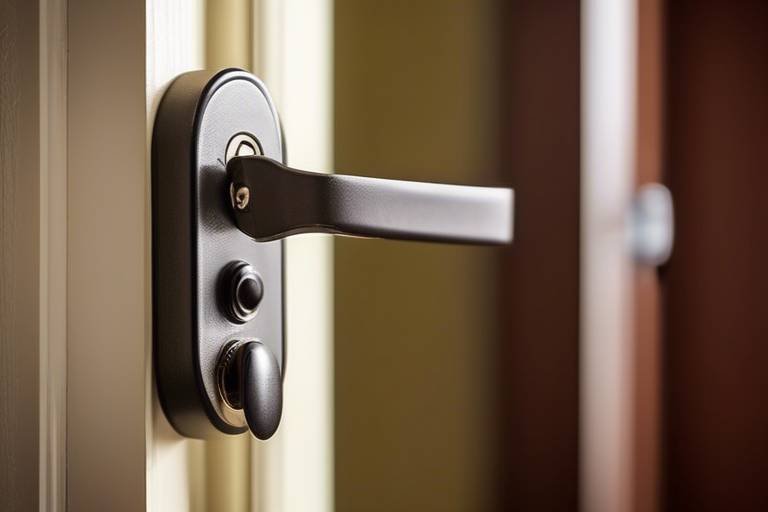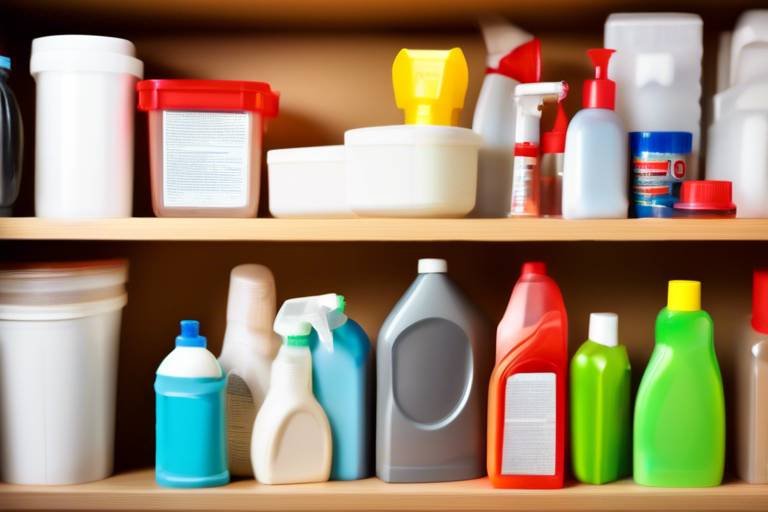Indoor Air Pollution - How to Improve Air Quality at Home
Indoor air pollution is a pressing issue that often goes unnoticed in our daily lives. It refers to the presence of harmful contaminants in the air we breathe within our homes, which can significantly impact our health and well-being. Many people might not realize that the air inside their homes can be more polluted than the air outside, primarily due to various sources of pollution that are often overlooked. From household cleaning products to mold and even outdoor pollutants that sneak in through cracks and crevices, understanding the sources of indoor air pollution is the first step toward improving air quality in your home.
So, what exactly contributes to indoor air pollution? Well, it's a mixed bag of culprits. Common sources include everyday household products such as paints, varnishes, and cleaning agents that release volatile organic compounds (VOCs) into the air. Additionally, mold can thrive in damp areas of your home, releasing spores that can exacerbate respiratory issues. Even outdoor pollutants, like pollen and vehicle exhaust, can find their way indoors through open windows and doors, or even on our clothes and shoes. It's like bringing a piece of the outside world into your sanctuary, but unfortunately, not all of it is pleasant.
Now, let's talk about why you should care about indoor air quality. Exposure to indoor air pollutants can lead to a myriad of health issues. In the short term, you might experience symptoms such as headaches, fatigue, and irritation of the eyes, nose, or throat. Over time, however, poor air quality can contribute to more serious conditions, including respiratory diseases, heart disease, and even cancer. It's alarming to think that the comfort of your home could be jeopardizing your health, but awareness is the first step to change.
Recognizing the symptoms associated with poor air quality is crucial for taking action. If you find yourself frequently experiencing headaches, unexplained fatigue, or persistent respiratory problems, it might be time to evaluate your indoor environment. These symptoms can often be dismissed as everyday stress or allergies, but they could very well be a signal from your body that your air quality needs improvement. Keep an eye out for these common indicators, as they can guide you toward a healthier living space.
Allergens such as dust mites, pet dander, and mold can significantly worsen indoor air quality. Identifying these allergens is essential for creating a healthier home. For instance, dust mites thrive in bedding and upholstery, while pet dander can linger in the air long after your furry friends have left the room. Mold, on the other hand, often hides in damp areas like bathrooms and basements. Regular cleaning and monitoring of these allergens can help you maintain a cleaner, healthier environment.
VOCs are chemicals found in many household products, including paints, air fresheners, and cleaning supplies. These compounds can evaporate into the air, leading to poor indoor air quality. Prolonged exposure to VOCs can cause a range of health problems, from headaches to liver damage. To minimize your exposure, consider using products labeled as "low-VOC" or "no-VOC," and always ensure that your living space is well-ventilated when using such products.
Proper ventilation is essential for maintaining good air quality. It allows fresh air to circulate and helps to remove stale air and pollutants. If your home is tightly sealed, it might be time to open a window or two. Consider installing exhaust fans in areas like kitchens and bathrooms to improve airflow. Remember, just like a plant needs sunlight and air to thrive, your home needs good ventilation to keep the air fresh and clean.
Improving indoor air quality doesn't have to be a daunting task. Here are some practical strategies you can implement right away:
- Regular cleaning: Dust and vacuum frequently to reduce allergens.
- Use air purifiers: Invest in a good quality air purifier to capture pollutants.
- Incorporate plants: Certain indoor plants can naturally filter the air.
By taking these simple steps, you can create a healthier living environment that promotes well-being for you and your family.
Air purifiers can significantly reduce indoor pollutants, but it's important to choose the right one. Look for purifiers with HEPA filters, as they are designed to capture small particles effectively. Additionally, place your air purifier in the most used areas of your home, such as the living room or bedroom, to maximize its effectiveness. Remember, even the best air purifier can’t replace good ventilation, so use them in conjunction with other air quality improvement methods.
Incorporating plants and natural solutions can also improve air quality. Some of the best indoor plants for air purification include:
- Spider Plant: Great for removing formaldehyde and xylene.
- Peace Lily: Effective at filtering out ammonia and benzene.
- Aloe Vera: Known for its air-purifying properties and healing benefits.
Additionally, consider DIY remedies such as using essential oils in diffusers, which can not only improve air quality but also create a pleasant aroma in your home.
Q: How can I tell if my indoor air quality is poor?
A: Look for common symptoms like headaches, fatigue, and respiratory issues. You can also use air quality monitors to get a more accurate assessment.
Q: Are air purifiers worth the investment?
A: Absolutely! They can help reduce allergens and pollutants, making your home a healthier place to live.
Q: What are some natural ways to improve air quality?
A: Incorporating indoor plants and using essential oils are great natural methods to enhance air quality.

Understanding Indoor Air Pollution
Indoor air pollution is a silent yet pervasive issue that affects countless households around the globe. It refers to the presence of harmful substances in the air we breathe indoors, often originating from various sources within our homes. Have you ever stopped to think about what might be lurking in the air of your cozy living room or kitchen? From household cleaning products to the mold that might be hiding behind your walls, the sources of indoor pollutants are diverse and sometimes surprising.
One of the most common culprits of indoor air pollution is household products. Many cleaning agents, paints, and even air fresheners contain volatile organic compounds (VOCs) that can evaporate into the air, creating a toxic environment. When you spray that fresh linen scent, do you consider the chemicals that are being released into your home? It's essential to be aware of these substances and their potential impact on your health.
Another significant source of indoor air pollution is mold. Mold thrives in damp areas, making bathrooms and basements prime locations for its growth. Not only does mold release spores into the air, but it can also lead to a host of health problems, particularly for those with respiratory issues. If you notice a musty smell or see dark spots on your walls, it’s time to take action and eliminate the source.
Additionally, outdoor pollutants can infiltrate your home. Pollution from traffic, industrial areas, and even pollen can find its way inside through open windows and doors. This means that even if you live in a relatively clean area, you could still be exposed to harmful particles. It's like inviting unwanted guests into your home without even realizing it!
To better understand the impact of these pollutants, let’s take a look at a table that summarizes some common sources of indoor air pollution:
| Source | Type of Pollutant | Potential Health Effects |
|---|---|---|
| Household Cleaning Products | VOCs | Headaches, dizziness, respiratory issues |
| Mold | Allergens | Allergic reactions, asthma attacks |
| Outdoor Air Pollution | Particulate Matter | Respiratory problems, cardiovascular issues |
| Pet Dander | Allergens | Allergic reactions, asthma |
Understanding these sources is the first step in combating indoor air pollution. By identifying where these pollutants come from, you can take proactive measures to reduce their presence in your home. Remember, a little awareness can go a long way in creating a healthier living environment for you and your loved ones.

Health Effects of Poor Air Quality
When we talk about poor air quality, we're not just discussing a minor inconvenience; we're delving into an issue that can have serious implications for our health. The air we breathe indoors can be filled with a mix of pollutants that can lead to various health problems, both in the short term and the long term. Imagine inhaling invisible toxins every day without even realizing it! It's a bit like swimming in a pool that looks clear but is teeming with bacteria. You might not see them, but they can definitely affect your health.
Short-term exposure to indoor air pollutants can cause immediate effects that are often mistaken for common ailments. For instance, you may experience headaches, dizziness, or even eye irritation. These symptoms can be easily dismissed as a result of stress or fatigue, but they may actually be a cry for help from your body, signaling that the air quality around you is less than ideal. In fact, studies have shown that people living in environments with poor air quality are more likely to report these symptoms. It's like your body is sending up a flare, urging you to take action.
But the effects of poor air quality don't stop there. Long-term exposure can lead to more severe health issues, particularly concerning our respiratory system. Chronic conditions such as asthma, bronchitis, or even lung cancer can develop as a result of prolonged inhalation of harmful pollutants. This is especially concerning for vulnerable populations, such as children and the elderly, who may already have compromised health. Just think of it this way: the air in your home should be a safe haven, not a breeding ground for illness.
Recognizing the symptoms associated with poor air quality is crucial for taking timely action. Here are some common indicators that your indoor environment might need a serious air quality makeover:
- Headaches: Frequent headaches can be a sign of high levels of indoor air pollution.
- Fatigue: Feeling tired all the time? Poor air quality might be contributing to your lack of energy.
- Respiratory Problems: Coughing, wheezing, or shortness of breath are clear signals that something is amiss.
These symptoms can often be alleviated by improving the air quality in your home. It's essential to pay attention to these warning signs and act swiftly to create a healthier living environment.
Allergens like dust mites, pet dander, and mold can significantly worsen air quality. These tiny intruders can trigger allergic reactions and exacerbate respiratory problems. For instance, dust mites thrive in warm, humid environments, and their waste can become airborne, leading to sneezing and itchy eyes. If you have pets, their dander can also contribute to indoor pollution. Identifying and managing these allergens is a critical step in combating poor air quality.
Another culprit in the indoor air pollution saga is volatile organic compounds (VOCs). These are chemicals found in many household products, including paints, cleaning supplies, and air fresheners. When these products are used, they can release VOCs into the air, leading to a range of health issues. Short-term exposure can result in headaches and nausea, while long-term exposure may lead to liver and kidney damage. Minimizing your exposure to VOCs is essential for maintaining a healthy indoor environment.
In conclusion, the health effects of poor air quality are not to be taken lightly. By understanding the symptoms and sources of indoor air pollution, you can take proactive steps to protect your health and well-being.
Q: What are the main sources of indoor air pollution?
A: Common sources include household cleaning products, mold, dust mites, pet dander, and VOCs from paints and furnishings.
Q: How can I tell if my indoor air quality is poor?
A: Look out for symptoms like headaches, fatigue, and respiratory issues, and consider using air quality monitors for precise measurements.
Q: What are some simple ways to improve indoor air quality?
A: Regular cleaning, using air purifiers, ensuring proper ventilation, and reducing the use of VOCs can significantly enhance air quality.

Common Symptoms of Air Quality Issues
Have you ever walked into a room and felt an immediate sense of discomfort? That could be your body reacting to poor air quality. It's not just about the visible dirt or dust; it's about the invisible pollutants that can wreak havoc on your health. Many people are unaware of the subtle signs that indicate air quality issues. Recognizing these symptoms is crucial for taking action to improve your indoor environment.
One of the most common symptoms of poor air quality is headaches. If you find yourself frequently reaching for pain relievers, it might be time to consider the air you’re breathing. Another prevalent issue is fatigue; feeling tired even after a full night's sleep can be a sign that your indoor air is less than ideal. You might also experience irritated eyes, nose, or throat, which can be particularly bothersome and is often mistaken for allergies or a cold.
Moreover, respiratory problems such as coughing or wheezing can be a direct result of indoor air pollutants. If you or your family members have asthma, you might notice that symptoms worsen indoors. In fact, the American Lung Association notes that indoor air can be two to five times more polluted than outdoor air, leading to serious health implications.
Here’s a quick breakdown of some common symptoms associated with poor air quality:
- Headaches
- Fatigue
- Irritated eyes, nose, or throat
- Coughing or wheezing
- Shortness of breath
- Sinus congestion
It's essential to pay attention to these symptoms, especially if they seem to improve when you leave your home or enter a different area. If you suspect that your home may be contributing to these issues, it’s time to take action. Your health is too important to ignore the signs!
In the next sections, we will delve deeper into how to identify specific allergens and pollutants in your home and what steps you can take to alleviate these symptoms. Remember, a little awareness can go a long way in ensuring a healthier living space for you and your loved ones.
As we wrap up, let’s address some common questions about indoor air quality:
- What are the main sources of indoor air pollution?
Common sources include household cleaning products, mold, pet dander, and outdoor pollutants that seep inside. - How can I tell if my air quality is poor?
Look out for symptoms like headaches, fatigue, and respiratory issues, as well as any visible mold or dust accumulation. - What can I do to improve indoor air quality?
Regular cleaning, using air purifiers, and ensuring proper ventilation can significantly enhance air quality.

Identifying Allergens in Your Home
When it comes to maintaining a healthy home environment, identifying allergens is a crucial step that often goes unnoticed. Allergens are substances that can cause allergic reactions, and they can lurk in the most unexpected places around your living space. Think of allergens as uninvited guests at a party – they can show up without warning and disrupt the entire atmosphere. Common culprits include dust mites, pet dander, mold spores, and even pollen that sneaks in through open windows and doors.
To effectively combat these sneaky allergens, it’s essential to first recognize where they might be hiding. For instance, dust mites thrive in warm, humid environments, making your bedding and upholstered furniture prime real estate for their population. Regularly washing your sheets in hot water and using dust-proof covers on mattresses can significantly reduce their numbers. Similarly, pet dander can cling to surfaces and fabrics, so if you have furry friends at home, make sure to vacuum frequently and consider using air purifiers designed to capture pet allergens.
Mold is another significant player in the allergen game. It loves damp areas, so keep an eye out for mold growth in places like bathrooms, kitchens, and basements. If you notice any suspicious spots, tackle them promptly with appropriate cleaning solutions. Additionally, maintaining low humidity levels in your home can help prevent mold from taking hold.
To help you identify specific allergens in your home, here’s a quick breakdown of common allergens and their sources:
| Allergen | Common Sources |
|---|---|
| Dust Mites | Bedding, carpets, upholstered furniture |
| Pet Dander | Fur, skin flakes, saliva from pets |
| Mold Spores | Bathrooms, kitchens, damp basements |
| Pollen | Open windows, plants, outdoor activities |
By being proactive and regularly cleaning your home, you can minimize the presence of these allergens. Consider implementing a routine that includes vacuuming with a HEPA filter, dusting surfaces, and washing textiles regularly. You might even want to invest in an air quality monitor to keep track of allergen levels in your home. Remember, a little effort in identifying and addressing allergens can lead to a significant improvement in your overall health and comfort.

Effects of Volatile Organic Compounds (VOCs)
Volatile Organic Compounds, commonly referred to as VOCs, are a group of chemicals that easily evaporate at room temperature. These compounds can be found in a variety of household products, including paints, cleaning supplies, air fresheners, and even in the materials used to build our homes, such as carpets and furniture. While they may make our living spaces smell nice or look fresh, the truth is that they can have significant effects on our health and indoor air quality. Understanding the impact of VOCs is crucial for creating a safe and healthy environment for you and your family.
When VOCs are released into the air, they can contribute to indoor air pollution, leading to a range of health issues. Short-term exposure to high levels of VOCs can cause symptoms such as headaches, dizziness, and irritation of the eyes, nose, and throat. Imagine walking into a freshly painted room; the smell might be pleasant, but it’s actually a sign of VOCs being released into the air. Over time, long-term exposure to these compounds can result in more severe health problems, including damage to the liver, kidneys, and central nervous system. In some cases, certain VOCs have even been linked to cancer.
Here’s a quick rundown of common sources of VOCs found in most homes:
- Household cleaners: Many cleaning products contain VOCs that can evaporate quickly.
- Paints and varnishes: These often release VOCs during and after application.
- Air fresheners: While they mask odors, they can also introduce harmful chemicals into the air.
- Furniture and carpets: New items can emit VOCs due to the materials they are made from.
To minimize exposure to VOCs, it’s essential to choose products wisely. Opting for low-VOC or no-VOC alternatives can make a world of difference. Additionally, ensuring proper ventilation when using products that contain VOCs can help disperse these harmful compounds more quickly. Opening windows, using exhaust fans, and maintaining airflow in your home can significantly reduce the concentration of VOCs in the air.
In conclusion, while VOCs are a common part of many household products, being aware of their effects and taking proactive steps can help improve your indoor air quality. By making informed choices and enhancing ventilation, you can create a healthier living space for you and your loved ones.

The Role of Ventilation
When it comes to maintaining a healthy indoor environment, ventilation plays a critical role. Think of your home as a living organism; just like we need fresh air to breathe and thrive, our living spaces require proper airflow to ensure that indoor air remains clean and safe. Without adequate ventilation, pollutants can accumulate, leading to a host of health issues. But what does proper ventilation entail, and how can you achieve it in your home?
First, let’s dive into what ventilation actually does. Essentially, it involves the process of exchanging indoor air with outdoor air. This exchange helps to dilute indoor air pollutants, reducing their concentration and keeping harmful substances at bay. There are two main types of ventilation: natural and mechanical.
Natural ventilation relies on natural forces such as wind and temperature differences. For instance, simply opening windows and doors can create a cross-breeze that helps to circulate air. However, relying solely on natural ventilation can be tricky, especially in urban areas where outdoor air quality may be compromised. On the other hand, mechanical ventilation uses fans and air conditioning systems to control airflow. This method is particularly beneficial in tightly sealed homes where natural airflow is limited.
To enhance ventilation in your home, consider the following strategies:
- Open windows and doors: Whenever the weather permits, allow fresh air to flow through your home.
- Use exhaust fans: Install exhaust fans in kitchens and bathrooms to remove moisture and odors.
- Install air exchange systems: Consider systems that can bring in fresh air while filtering out pollutants.
- Maintain HVAC systems: Regularly change filters and ensure that your heating and cooling systems are functioning optimally.
Moreover, the placement of air vents and windows can significantly affect the airflow in your home. For instance, placing vents near heat sources can help warm air circulate more effectively, while strategically opening windows can create a natural airflow pattern. It’s all about creating a balance between incoming and outgoing air.
In addition to improving air quality, good ventilation can also help regulate temperature and humidity levels, making your home more comfortable. High humidity can lead to mold growth, while stagnant air can make a space feel stuffy and uncomfortable. By ensuring proper ventilation, you can create a more pleasant living environment while safeguarding your health.
In conclusion, never underestimate the power of ventilation. It’s like the lungs of your home, breathing in fresh air and exhaling the stale, polluted air. By implementing effective ventilation strategies, you can significantly enhance the air quality in your home, leading to a healthier and happier lifestyle.
- What are the signs of poor ventilation in my home? Symptoms include musty odors, excessive humidity, and visible mold growth.
- How often should I ventilate my home? Ideally, you should ventilate your home daily, especially in areas like kitchens and bathrooms.
- Can I improve ventilation without opening windows? Yes! Using exhaust fans and air purifiers can help improve air circulation even without open windows.

Practical Tips for Improving Air Quality
Improving the air quality in your home is not just a luxury; it's a necessity for your health and well-being. With the rise in indoor air pollution, it’s essential to take proactive steps to ensure that the air you breathe is clean and safe. So, how can you achieve this? Well, let’s dive into a few practical tips that can transform your living space into a healthier environment.
First and foremost, regular cleaning is paramount. Dust and allergens tend to accumulate quickly, especially in areas that are often overlooked. Make it a habit to vacuum carpets and rugs at least once a week, and don't forget to use a vacuum cleaner equipped with a HEPA filter. This type of filter traps tiny particles that can cause respiratory issues. Additionally, consider washing your bedding and curtains regularly, as they can harbor dust mites and other allergens.
Another effective strategy is to incorporate air-purifying plants into your home decor. Certain plants, such as spider plants, peace lilies, and snake plants, are known for their ability to absorb toxins and release oxygen. Not only do they improve air quality, but they also add a touch of nature to your space, creating a calming atmosphere. Imagine walking into a room filled with greenery; it’s like a breath of fresh air, quite literally!
Moreover, using air purifiers can significantly enhance your indoor air quality. But how do you choose the right one? Look for models that are equipped with HEPA filters and activated carbon, as they efficiently capture both particulate matter and odors. Place these purifiers in high-traffic areas or rooms where you spend the most time, such as the living room or bedroom. To maximize their effectiveness, keep windows and doors closed when the purifier is running; this will create a sealed environment for cleaner air circulation.
Don’t underestimate the power of proper ventilation. Opening windows and doors can help reduce indoor pollutants by allowing fresh outdoor air to flow in. However, this may not always be feasible, especially in urban areas with high levels of outdoor pollution. In such cases, consider installing exhaust fans in kitchens and bathrooms to help expel humid air and odors. Additionally, using air exchange systems can help maintain a balance between indoor and outdoor air quality.
Let’s not forget about the impact of volatile organic compounds (VOCs) that are commonly found in household products. From paints and cleaning supplies to air fresheners, these chemicals can linger in the air and pose health risks. To minimize exposure, opt for low-VOC or VOC-free products whenever possible. You might also want to consider making your own cleaning solutions using simple ingredients like vinegar and baking soda, which are effective and much safer for your indoor environment.
In summary, improving air quality at home doesn’t have to be overwhelming. By implementing these practical tips, you can create a healthier living space for you and your family. Remember, a few small changes can lead to significant improvements in your indoor air quality, making your home a sanctuary of fresh, clean air.
Q: How often should I change the filters in my air purifier?
A: It's generally recommended to change the filters every 3 to 6 months, depending on usage and the model of your purifier.
Q: Are there specific plants that are best for improving indoor air quality?
A: Yes, plants like peace lilies, spider plants, and snake plants are known for their air-purifying capabilities.
Q: Can indoor air pollution affect my sleep?
A: Absolutely! Poor air quality can lead to respiratory issues and discomfort, which can disrupt your sleep patterns.
Q: Is it necessary to use an air purifier if I have good ventilation?
A: While good ventilation is essential, an air purifier can provide an additional layer of protection by filtering out fine particles and allergens.

Using Air Purifiers Effectively
When it comes to enhancing the air quality in your home, air purifiers are like superheroes in disguise. They swoop in to save the day, filtering out harmful pollutants and allergens that can wreak havoc on your health. But, to truly harness the power of these devices, it’s essential to use them effectively. First off, consider the size of the room where you plan to use the purifier. Each device is designed to cover a specific area, so choosing one that fits your space is crucial. A purifier that’s too small for a large room will struggle to keep the air clean, much like trying to fill a swimming pool with a garden hose!
Next, think about the type of filter the purifier uses. HEPA (High-Efficiency Particulate Air) filters are highly recommended because they can trap 99.97% of particles that are 0.3 microns or larger. This means they can capture dust, pollen, pet dander, and even some bacteria and viruses. If you have specific concerns, such as smoke or odors, look for purifiers with activated carbon filters, which excel at absorbing these unwanted scents.
Placement is also key to maximizing the effectiveness of your air purifier. Ideally, you should position it in a central location within the room, away from walls or furniture that could obstruct airflow. Think of it as giving your purifier the best seat in the house! Additionally, keeping doors and windows closed while the purifier is running can help maintain a consistent level of clean air.
Another important factor is the cleaning and maintenance of your air purifier. Many people overlook this aspect, but it’s vital for ensuring optimal performance. Regularly check and replace filters according to the manufacturer's instructions. A clogged filter can be counterproductive, allowing pollutants to pass through rather than trapping them. Some purifiers even have filter change indicators, which can help you stay on top of maintenance.
To get the most out of your air purifier, consider running it continuously, especially during peak allergy seasons or when air quality is poor. This might seem excessive, but just like your favorite playlist, the more you listen, the better you feel! If noise is a concern, many modern purifiers operate quietly, allowing you to enjoy clean air without the disruptive hum.
Lastly, don’t forget to combine the use of your air purifier with other air quality improvement strategies. Regular cleaning, minimizing clutter, and using natural cleaning products can enhance the overall effectiveness of your purifier. Think of it as a team effort—your purifier is the star player, but it needs a solid supporting cast!
Q: How often should I run my air purifier?
A: It's best to run your air purifier continuously, especially during times when allergens or pollution levels are high.
Q: Can I use multiple air purifiers in my home?
A: Absolutely! Using multiple purifiers in different rooms can significantly enhance your overall air quality.
Q: How do I know when to replace the filter?
A: Check the manufacturer's guidelines, but many purifiers have indicators to alert you when it's time for a filter change.
Q: Will an air purifier help with pet allergies?
A: Yes! Air purifiers with HEPA filters are particularly effective at trapping pet dander and other allergens.

Natural Remedies for Cleaner Air
Improving indoor air quality doesn’t always require expensive gadgets or complicated systems. In fact, some of the most effective solutions can be found right in your home or garden! Natural remedies can significantly enhance the air you breathe, making your living space healthier and more pleasant. Have you ever considered that certain plants not only beautify your home but also purify the air? Yes, you heard that right! Let’s dive into some of the best natural remedies for cleaner air.
One of the simplest and most effective ways to improve air quality is by incorporating indoor plants. These green companions are not just for decoration; they can absorb toxins and release oxygen, creating a fresher atmosphere. Some of the top air-purifying plants include:
- Spider Plant: Known for its resilience, this plant is excellent at removing pollutants like formaldehyde.
- Pothos: A hardy plant that thrives in low-light conditions and can eliminate indoor toxins.
- Peace Lily: This lovely flower not only adds beauty but also helps filter out harmful chemicals.
- Aloe Vera: Besides its medicinal properties, aloe vera can absorb carbon dioxide and release oxygen, improving air quality.
Another fantastic natural remedy is using essential oils. Not only do they smell wonderful, but many essential oils also have air-purifying properties. For instance, tea tree oil and lavender oil can help reduce airborne bacteria and viruses. You can diffuse these oils in your home or add a few drops to a spray bottle filled with water for a DIY air freshener. Just imagine walking into a room that smells like a serene forest or a fresh lavender field!
Additionally, consider making your own natural air fresheners. Mix water with vinegar and essential oils in a spray bottle for a simple yet effective solution. Vinegar is known for its ability to neutralize odors, while essential oils provide a pleasant scent. This combination can help eliminate unwanted smells without the harsh chemicals found in commercial air fresheners.
Another surprising remedy is the use of activated charcoal. This powerful substance can absorb impurities and odors from the air. You can place small bags of activated charcoal in various rooms to help keep the air fresh. It’s like having a silent guardian against unpleasant smells!
Lastly, don’t underestimate the power of regular cleaning. Dust, pet dander, and other allergens can accumulate quickly, leading to poor air quality. Make it a habit to vacuum regularly, wash your bedding, and dust surfaces to keep your home clean and fresh. Incorporating natural cleaning products, like baking soda and lemon juice, can also help you maintain a healthier environment.
In summary, enhancing your indoor air quality can be as simple as adding a few plants, utilizing essential oils, and maintaining cleanliness. By embracing these natural remedies, you can create a more inviting and healthier living space for you and your loved ones.
Q: How many plants do I need to improve air quality?
A: While there’s no specific number, having several plants in different rooms can significantly enhance air quality. Aim for at least one plant per 100 square feet for optimal results.
Q: Are essential oils safe for pets?
A: Some essential oils can be harmful to pets. Always research which oils are safe and consult with your veterinarian before using them in your home.
Q: How often should I clean my home to maintain good air quality?
A: Regular cleaning is essential. Aim to vacuum and dust at least once a week, and wash bedding and curtains every few weeks to reduce allergens.
Frequently Asked Questions
- What are the main sources of indoor air pollution?
Indoor air pollution can stem from various sources. Common culprits include household cleaning products, paints, mold, pet dander, and even outdoor pollutants that sneak in through open windows and doors. It's essential to be aware of these sources to effectively tackle air quality issues in your home.
- How does poor indoor air quality affect health?
Exposure to indoor air pollutants can lead to a range of health problems, from short-term irritations like headaches and fatigue to long-term issues such as respiratory diseases and cardiovascular problems. It’s like living in a bubble filled with toxins that can gradually wear down your health.
- What symptoms indicate poor air quality?
Some common symptoms of poor air quality include frequent headaches, fatigue, dry throat, and respiratory issues like coughing or wheezing. If you notice these signs, it might be time to investigate your indoor air quality and make some changes.
- How can I identify allergens in my home?
To identify allergens, start by checking common areas where dust mites and mold thrive, such as carpets, bedding, and damp corners. Regular cleaning and using allergen-proof covers can help reduce these irritants. Think of it as a treasure hunt for hidden allergens!
- What are Volatile Organic Compounds (VOCs) and their effects?
VOCs are chemicals found in many household products, including paints, cleaners, and air fresheners. They can cause various health issues, including headaches and nausea. Minimizing exposure by using low-VOC products can significantly enhance your indoor air quality.
- Why is ventilation important for air quality?
Good ventilation is crucial because it helps circulate fresh air and dilute indoor pollutants. Without proper airflow, harmful substances can accumulate, leading to health risks. Think of ventilation as your home’s breathing system—keeping it fresh is vital!
- What practical steps can I take to improve indoor air quality?
There are several effective strategies to boost indoor air quality, such as regularly cleaning your home, using air purifiers, and incorporating indoor plants. Each of these methods contributes to creating a healthier living environment, much like putting together a puzzle for your well-being.
- How do I choose the right air purifier?
When selecting an air purifier, consider factors like the size of the room, the type of filters used, and the specific pollutants you want to target. Look for models with HEPA filters, as they are excellent at trapping small particles. It’s like finding the perfect tool for a job—having the right one makes all the difference!
- Are there natural remedies to improve air quality?
Yes! Incorporating certain indoor plants, like spider plants and peace lilies, can naturally purify the air. Additionally, DIY remedies like using baking soda to absorb odors can also help. Think of these natural solutions as your green allies in the quest for cleaner air!



















